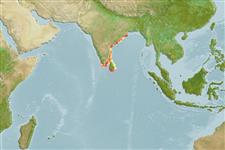>
Scombriformes (Mackerels) >
Trichiuridae (Cutlassfishes) > Trichiurinae
Etymology: Lepturacanthus: Greek, leptos = thin + Greek, oura = tail + Greek, akantha = thorn (Ref. 45335).
Environment: milieu / climate zone / depth range / distribution range
Ökologie
seewasser; brackwasser benthopelagisch; tiefenbereich 0 - 80 m (Ref. 6181). Tropical; 21°N - 5°N, 76°E - 87°E (Ref. 6181)
Indian Ocean: Hooghly estuaries to Gulf of Mannar in the east coast of India.
Size / Gewicht / Alter
Maturity: Lm ? range ? - ? cm
Max length : 92.0 cm TL Männchen/unbestimmt; (Ref. 6181); common length : 40.0 cm TL Männchen/unbestimmt; (Ref. 6181)
Kurzbeschreibung
Morphologie | Morphometrie
Rückenflossenstacheln (insgesamt): 3; Rückenflossenweichstrahlen (insgesamt): 121-131; Afterflossenstacheln 2; Afterflossenweichstrahlen: 74 - 84. Body extremely elongate, compressed and tapering to a point. Anal fin reduced to a long spine and 74 - 84 smaller spinules; pelvic and caudal fins absent. Lateral line running nearer the ventral contour than the dorsal contour of the body. Body color steely blue with metallic reflections in fresh specimens, becoming silvery gray after death.
Benthopelagic or pelagic in estuaries and coastal waters. Feeds on a wide variety of small fishes and crustaceans chiefly on prawns, young clupeoids, Harpodon nehereus and Trichiurus spp. in Hooghly estuaries, India. Caught mainly with bag nets in estuaries, with shore seines and boat seines in inshore waters, and with trawls in off-shore waters. Marketed fresh as well as dried salted.
Life cycle and mating behavior
Geschlechtsreife | Fortpflanzung | Ablaichen | Eier | Fecundity | Larven
Nakamura, I. and N.V. Parin, 1993. FAO Species Catalogue. Vol. 15. Snake mackerels and cutlassfishes of the world (families Gempylidae and Trichiuridae). An annotated and illustrated catalogue of the snake mackerels, snoeks, escolars, gemfishes, sackfishes, domine, oilfish, cutlassfishes,. scabbardfishes, hairtails, and frostfishes known to date. FAO Fish. Synop. 125(15):136 p. (Ref. 6181)
IUCN Rote Liste Status (Ref. 130435)
Bedrohung für Menschen
Harmless
Nutzung durch Menschen
Warning: mysqli::__construct(): (08004/1040): Too many connections in /var/www/html/includes/func_getlabel.php on line 46
Can't connect to MySQL database (fbapp). Errorcode: Too many connections
